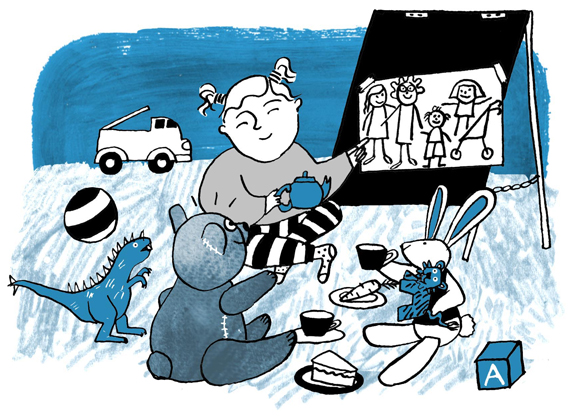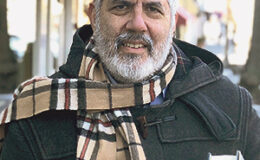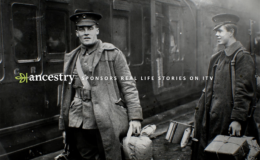

“The fast-evolving family portrait has left certain sections of the adult population struggling to keep up.” Illustration: Kate Hazell
If you were to ask my daughter who is in our immediate family, she’d tell you myself, her grandmother, her pram and her auntie—in that order. Sometimes our car gets a billing, too. The humans in that list were all present at her birth while the pram shares our home, giving it a status adjacent to that of family pet. What unites us, humans and vehicles alike, is that we appear to exist primarily to do her bidding.
It’s an interpretation of family that turns out to hew closely to the word’s origins, which lie in the Latin familia, meaning a household’s servants. But if she’s as mercenary as the rest of her tribe of small ones, my daughter is every bit as stoutly forward-thinking, too. When I was growing up in the 1980s, the most exotically-shaped family trees were those that had been espaliered to include step-thises and -thats. Her cohort already numbers not only the children of second marriages and fellow solo mums, but also of gay couples, a traditional mummy-daddy duo who used an egg donor, and most recently a transitioning (and divorcing) father. That each of these families looks a little different to some of those in her storybooks is accepted without comment.
Would that the rest of the world were as accepting as the under-fives. Instead, this fast-evolving family portrait has left certain sections of the adult population struggling to keep up. As modern kinship kaleidoscopes into new and ever more intriguing formations, a scuffle over the definition and ownership of the word “family” has broken out, establishing yet another battlefront in the interminable culture wars. It has been co-opted by those for whom it’s inseparable from laden words such as “values.”
For instance, on the other side of the Atlantic, “family friendly”—a mild term that once stood for middling entertainment and dismal dining experiences—has been weaponised to menace even the Hallmark Channel, a saccharine purveyor of the myth that family is one giant, marshmallow-y group hug. At the end of last year, the channel aired adverts for a wedding company that depicted a lesbian couple kissing, inciting the ire of a group calling itself One Million Moms (1MM). “It is clear that Hallmark is no longer family friendly, and parents will need to exercise caution before heading to the channel,” huffed a 1MM statement.
Hallmark was hardly breaking new ground. Ikea first featured a gay couple in its campaigns more than 20 years ago, but more recently, companies from Lucky Charms to Wells Fargo in the US, and McCain’s and Argos here in the UK, have followed suit. “We live in a world where the meaning of family is bigger, broader and more personal than it has ever been before,” Ralph Lauren’s chief marketing officer commented last year, when the company included its first gay couple in a campaign titled “Family is who you love”.
While there’s a pungently American flavour to the Hallmark episode, the backlash isn’t localised. The gay dads who appeared in oven chip giant McCain’s 2017 “We Are Family” campaign became the focus of homophobic abuse on social media, and across Europe the rise of the far right has legitimised organisations like the World Congress of Families. That Christian right coalition, whose mission is to protect the “natural family,” has mostly held its annual conference in former Soviet states; in 2019, it boldly chose a country synonymous with an exuberant, laidback ideal of all things familial: Italy. (Then again, it chose Verona, which thanks to the Bard tees up associations not only of romance, but also tragically doctrinaire parenting.)
It isn’t only the LGBT community that is being targeted: any family unit that doesn’t conform to the norm is viewed as morally suspect, and that includes society’s eternal scapegoat, the single mother. In Poland last year, the government went so far as to enact a law barring single women from accessing their own frozen embryos. Could it happen here? Well, it’s not that long ago that Iain Duncan Smith and David Cameron made a doomed attempt to make IVF conditional on a father figure being around.
Science, of course, has been instrumental in opening up new possibilities for the configurations that family may take. Yet just as it’s been creating novel familial relationships, like those between biological half-siblings, born into different families but conceived using the same sperm or egg donor, so, thanks to accessible DNA testing, it’s revealed the rigidity of our previous definitions to have been something of a fib all along. Yes, the bulk of genealogy kits come back without scandalous revelations, but even they dangle the possibility of third cousins fanning out across the globe, stretching to gregarious extremes the notion of family as being blood-based and diluting its innate exclusivity.
Back at ours, we’ve become a two-family household, sharing our home with an ever-expanding clan of soft toys. Through the stories she tells, I can see that my daughter understands family to be all about relationships and attachments, and she’s not about to let trifling matters of scale or species, never mind DNA, get in the way. After all, why shouldn’t a small tiger be big sis to a large bear? And come to think of it, why can’t Peter Rabbit be their mummy? So long as he/she/they/ze knows that they’re fully indentured to their offspring.














